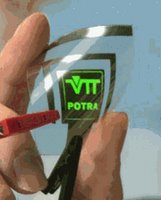Unfortunately, it isn't like that at all. The overwhelming perception of chemists is that when they're not arsing around in white coats, they're polluting the planet, torturing animals or mercilessly ripping off third world countries. Quite how this has happened isn't too apparent, but by and large the only thing you read about in the news are the bad sides of chemistry: testing drugs on animals, massive plants bellowing out smoke, drugs with bad side effects... but this rant isn't about that.
The one positive we're getting as chemists is in the form of nanotechnology, but even that is about to go wrong.
 Yesterday we received a talk from Professor Tony Ryan (right) on nanotechnology. Despite looking like Sam from Lord of the Rings, Ryan is one of the UK's most high profile chemists and presented the 2002 Royal Institute Christmas Lectures - the only time in the 10 years or so I've been watching them that chemistry was featured. His group at the University of Sheffield are working on synthetic muscles, but the first part of his talk was about the dangers of hyping up these new ideas with no science to back them up.
Yesterday we received a talk from Professor Tony Ryan (right) on nanotechnology. Despite looking like Sam from Lord of the Rings, Ryan is one of the UK's most high profile chemists and presented the 2002 Royal Institute Christmas Lectures - the only time in the 10 years or so I've been watching them that chemistry was featured. His group at the University of Sheffield are working on synthetic muscles, but the first part of his talk was about the dangers of hyping up these new ideas with no science to back them up. The term was coined by the Japanese in the 70s to suggest synthesis and analysis on an atomic or molecular level. The bandwagon started it's roll to the current-day expectation when in the early 80s, Eric Drexler released the book Engines of Creation. His imagery of "Grey Goo" - a vision of a future where nanobots escaped the labs and endlessly replicated and broke all matter down.

He predicted that Star-Trek-esque machines would be able to assemble anything atom by atom if we knew which atoms were needed where... The worst thing that could happen did: the popular press and a bunch of pseudo-scientists cottoned on to it. Cue the setting up of the Institute for Molecular Manufacturing in 1991, which to this day has manufactured precisely bugger all save for some pretty computer images of "molecular machines".
Even such widely read magazines as Time Magazine ran cover stories picturing small machines the size of a human blood cell that would one day be able to swarm around our bodies in their trillions patching us up, performing surgery at a microscopic level and keeping us healthy. Of course, most A-Level students could tell you straight away that these just won't work and aren't feasible.
 Look at the picture and despite their seeming well intentioned ideas, it don't doesn't hang together. Let's forgo the fact that anything as small as proposed (in the fashionable "human hair" units - I guess 10-9m would intimidate most people) would never be able to have such intricate detail and think back to basic chemistry and physics. At the microscopic levels, any science student will tell you that small particles move randomly due to Brownian Motion. Given that you can see particles displaying this phenomenon on a macroscopic level - you can imagine how unsteady these robot surgeons would be. If something is going to operate on my insides I rather it didn't shake around randomly... Moving on, most people will have heard of Van der Waals forces - instant spontaneous polarisations that make small molecules stick together. For a machine this small, all that would happen is that not only would they stick together, they'd also attract all the gunk that normally floats around our bodies - essentially getting lost in the biological gunk that makes us up.
Look at the picture and despite their seeming well intentioned ideas, it don't doesn't hang together. Let's forgo the fact that anything as small as proposed (in the fashionable "human hair" units - I guess 10-9m would intimidate most people) would never be able to have such intricate detail and think back to basic chemistry and physics. At the microscopic levels, any science student will tell you that small particles move randomly due to Brownian Motion. Given that you can see particles displaying this phenomenon on a macroscopic level - you can imagine how unsteady these robot surgeons would be. If something is going to operate on my insides I rather it didn't shake around randomly... Moving on, most people will have heard of Van der Waals forces - instant spontaneous polarisations that make small molecules stick together. For a machine this small, all that would happen is that not only would they stick together, they'd also attract all the gunk that normally floats around our bodies - essentially getting lost in the biological gunk that makes us up.What Professor Ryan brought home to us was that politicians read these kind of books and magazines. I'd never thought about this much before, but it's true - to pretty much guarantee funding for research all you have to do is mention nanotechnology and people will be falling over themselves to give you money without really understanding where it's going. Indeed, my research group is part of the Durham Nanomaterials project. The problem is that the 1980s were actually a long time ago (scary) and so far not much has been delivered. Journals are full of "promising" materials, but not much has made it to market.

My field of OLEDs has long been touted to replace LCD screens, but despite being on the verge of release for the last 5 years we're not really inundated with thin flexible, low powered screens. In fact, in the mean time LCD technologies have improved drastically and alternative technologies such as SED as gearing up for launch early next year in Japan. The public expects, and pretty soon, the policy makers are going to wonder where all their money went and chemistry won't even have the white knight of Nanotechnology to promote itself.
Meanwhile, Drexler and his apostles have been attacking anyone who dares to doubt his vision of nanomachines that can outperform nature, including Nobel Prize winner Richard Smalley. That nature has created nanoscale machines suggests that we one day might get close, but after all, nature has had several billion years to get things right...

No comments:
Post a Comment